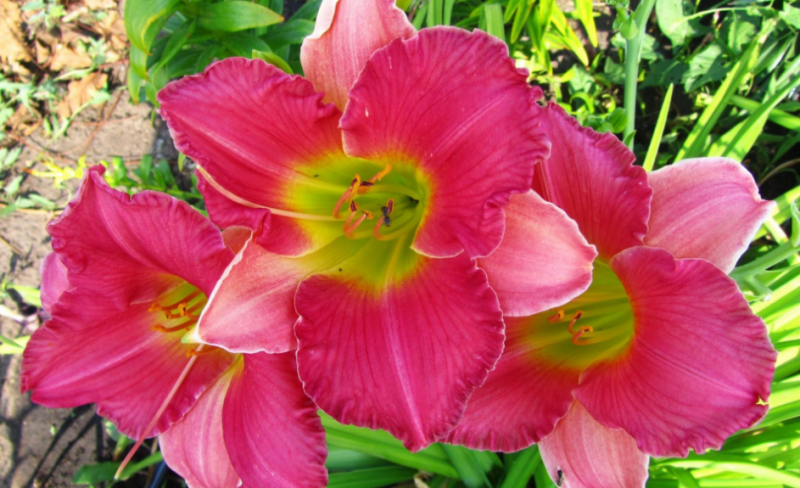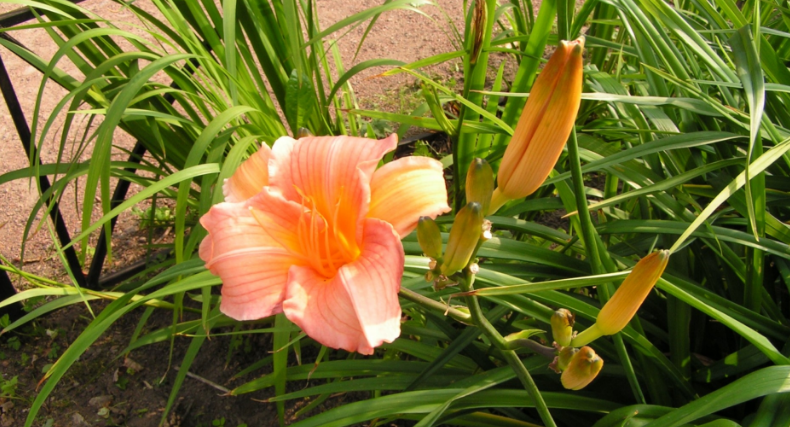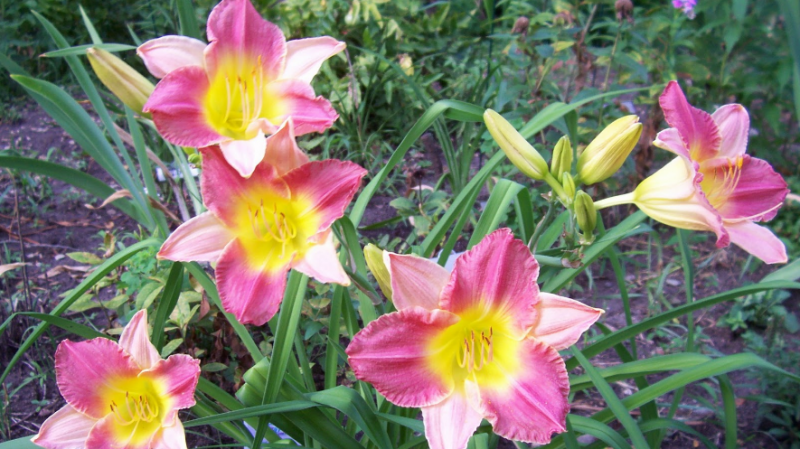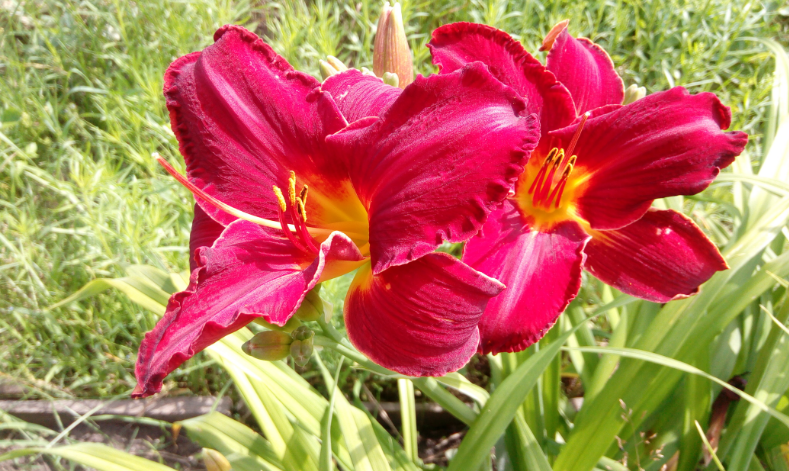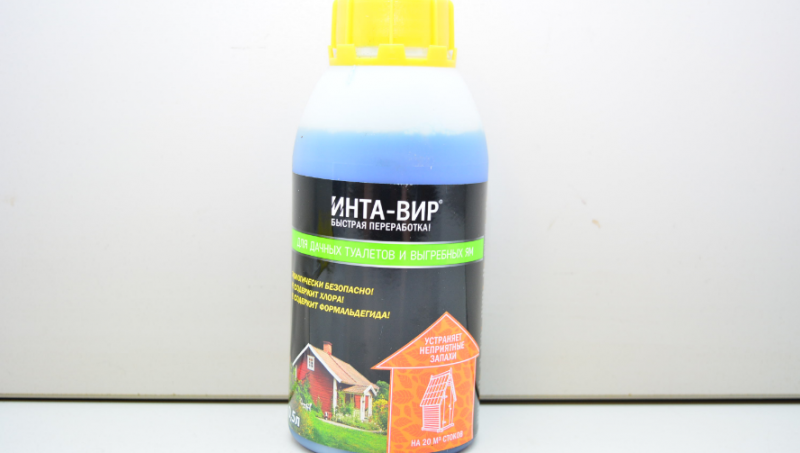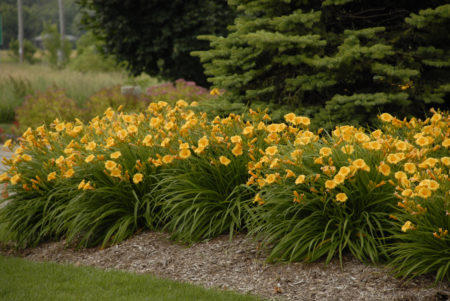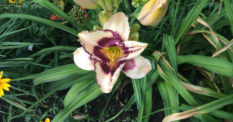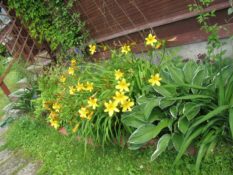Hybrid daylily or hemerocallis stands out among the huge number of ornamental plants for the infield, the brightness of colors and the splendor of flowering. This flower is quite unpretentious, and even an inexperienced gardener will cope with its cultivation.
Material Content:
Characteristics and description of the plant
The birthplace of the species is Asia. This is a variety of perennial daylily. The plant has a powerful root system that accumulates a lot of moisture. Due to this feature, he is not afraid of even a prolonged drought.
Leaves are only basal, curved, long. The flowers have a diverse color, flowering lasts more than three weeks. Varieties that bloom throughout the summer are bred.
Classification and varieties of hybrid daylily
According to the timing of flowering, krasnodne is divided into the following types:
- Early - blooms in June, is able to do this repeatedly.
- Medium - blooms in July.
- Late, blooming in late August.
Hybrid daylilies are also classified by color. In total, there are 18 groups of flamboyant with pure shades. Breeders bred various decorative terry varieties, semi-terry, the beauty of which is literally amazing.
All varieties of daylilies are simply impossible to list, so many of them.
But the plant is divided into groups:
- Double terry. They are represented by the Double Curity, Double Royal and others.
- Arachnids are red-blooded, the flowers of which resemble spiders. Bright representatives of the variety are Helix and Free Healing.
- Fragrant species, the color of which can have the most diverse color. Especially good are Apple Spring and Stella do Oro.
- White daylilies are considered only conditionally white.This variety includes Apple Blosson White and Granny Smith.
The most popular varieties suitable for cultivation in the middle lane are the hybrid daylily AveryDailili and daylily Jean Swan.
Outdoor landing
This plant is very fond of light, so the site for planting must be sunny. But in the southern regions it is better to place daylilies in light partial shade. Experienced flower growers know that dark-colored varieties also feel great precisely in such conditions, otherwise the flower petals will quickly fade in the sun.
Daylilies prefer fertile soil, although they can even put up with poor soil. If the land on the site is heavy, then when planting in the pit add river sand and well-rotted manure. When there are sandstones in the area, horse manure or mature compost is added during planting.
Soil acidity is also important. Slightly acidic soil is the best for floriculture. If the soil layer in the plot is acidified, then in the process of planting, ash or dolomite flour is added.
Seedlings are chosen with several buds and well-developed roots. Planting time is early spring or mid-autumn. These are unpretentious plants for the garden, the planting of which is very simple.
It is necessary to dig a hole at least 50 cm deep, even if the daylily delineation is very small. The diameter of the planting hole is chosen depending on the width of the root system of the seedling. Subsequently, the pit is filled with fertile soil. First, a knoll is made at the bottom of the hole and it is well shed with water. When the moisture is gone, the liberated part of the plant is planted in a hole, straighten the roots and fall asleep with earth. The root neck must certainly be flush with the surface of the soil. After planting, the soil around the seedling is slightly tamped and shed. If several specimens are planted, then a minimum of 50 cm is left between them.
Many flower growers fertilize when planting so that the young bushes grow faster and bloom. You can add a mixture of "Kemira Autumn" or "Kemira Wagon."
Post planting care tips
Krasnodnev has a powerful root system that accumulates a lot of water, so it is often not necessary to water it. Although the plant is very fond of moisture, drought is not afraid of him. Quite a “drink” very plentifully once a week. With age, the roots go far deep into the earth, so young, not yet strong plants need to be moistened often and generously.
A mandatory step in caring for the day is mulching. As mulch, you can use pine bark, mowed grass, peat or coniferous litter. The mulching layer is spread out about 6 cm thick. This will help to keep moisture near the roots and prevent weed germination. In addition, in the heat of the mulch does not allow the earth to warm up so much.
Read also:mulching
Withered flowers need to be pruned throughout the season. This allows you to preserve the decorativeness of the bushes and will stimulate the plant to more magnificent flowering. It is necessary to completely cut off those peduncles on which the seed bolls, which take away the forces from the plants, have ripened.
Throughout the season, daylilies weed and loosen the soil around them to provide oxygen access to the roots.
Feeding and fertilizing daylily
In the first year, perennial hybrids do not need to be fed, because when planting, the necessary amount of nutrients was introduced. In subsequent years, bushes should already be fertilized.
In May, urea is fed. In June, the red days are preparing to bloom, so when watering universal mineral mixtures, for example, Kemira, are introduced.
After colorful flowering, daylilies are depleted, and they need additional nutrition. Plants begin to rest, and also during this period flower buds of the next year are laid. Before autumn, Kemira Autumn is fertilized for a day.
We must not forget that if the plot is acidified, throughout the season during irrigation it is advisable to add dolomite flour to the water.
Breeding methods
Daylilies can be propagated by seed or division. It is worth considering that when growing by seed method, only natural species retain the varietal qualities of mother plants. Hybrids may not inherit the characteristics of the variety. Vegetative propagation provides guaranteed stable results, and also much easier.
Share bushes in the spring. Since this plant wakes up very early, immediately after the bush leaves the snow, it can be dug up and divided into several divisions. If you bother reddening before spring heat arrives, you can never wait for flowers in the summer.
If the bush is about 4-5 years old, then it is suitable for reproduction. The plant is dug up with a shovel from all sides and, together with a lump around the roots, is removed from the ground. We must try to divide the plant so that each had leaves and roots. It is most convenient to cut the rhizomes with a sharp shovel or a large knife.
Then each part is planted in the garden. Caring for them is no different from similar events arranged for adults. In one place, the red-day is able to grow up to 15 years, but when dividing such an old bush, the florist may have difficulties. The reason for this is the fact that they take root well after transplantation of delenki with young roots. In an adult plant that is already many years old, the root system is old.
Daylily can be propagated in autumn as follows:
- In early September, undermine the bush on three sides.
- Then, with a shovel, cut off the dividend and extract.
- Cover the appeared hole with earth, and plant the separated part in a new place.
Diseases and pests
Thrips can cause serious damage to landings. Insects climb up the stems and suck out the juices. Then the pests penetrate the buds and eat them. They hibernate under the roots in the ground, therefore, if thrips were noticed, the peduncle is cut and burned. Do the same with affected foliage. The soil under daylilies is treated with an Inta-Vira solution.
Even the bushes may be attacked by a lily mosquito. Parasitic insects lay eggs in flowers, then the appeared larvae feed on the juices of buds. Such flowers must be cut and burned.
Huge damage to flower beds can cause voles, including plant roots in their diet. Fight rodents with poisons.
Often the flowers are invaded by aphids, against which the plant should be regularly sprayed with Actellik. Juicy leaves like to feast on slugs, which will have to be collected manually.
Other parasites, such as the spider mite, are also threatening the Reds. In case of the appearance of the thinnest cobweb on the leaves of the plant, it should be sprayed with an insecticide, strictly following the instructions for the drug.
Of the diseases, root rot is most often noted. If the growth of the bush suddenly stopped or the bush began to be easily removed from the soil, just pull the leaf slightly, then its roots began to rot.
To save the affected plants, they must be dug up and rinsed with rinses. Sore spots are removed, cutting to a healthy part. Then the bushes are planted in a new place.
If the root neck has rotted at the daylily, which happens mainly due to overflows, it follows:
- Dig out the whole bush, cut out the diseased areas.
- Rinse the plant in a solution of manganese.
- Treat all sections with fungicides.
- Dry the rhizomes in the air for 24 hours, then plant them in a new place.
It is interesting:perennial chrysanthemums
Use in landscape design
Daylily, whose bloom is striking in its colorfulness, is often used in floral arrangements in landscape design. Perfectly looking bushes are flamboyant along the park paths, in a single landing in the middle of an emerald green lawn. They are decorated with gardens, shores of artificial ponds, planted them next to the fountains.
These flowers look very decorative at night, which is often used by designers, designing the design of personal plots and territories of nightlife venues.
Hybrid daylily, the varieties of which are so diverse, surprisingly unpretentious plant. For little attention, the redneck thank you with a long and plentiful flowering.


